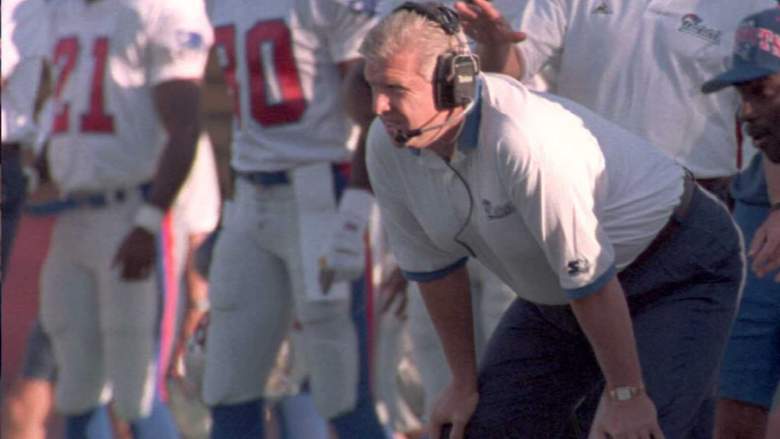
Getty Bill Parcells explained the draft system that helped the New England Patriots find future Hall of Famers and build a Super Bowl-level roster.
Bill Parcells rebuilt the New England Patriots and laid the foundations for an eventual dynasty through smart drafting that consistently found hidden talent, including the story of how Tedy Bruschi went from unheralded Round 3 pick to franchise Hall of Famer.
Parcells, who took the Patriots from 2-14 to the Super Bowl in four years, explained the drafting system that served him so well from 1993 to ’97. Writing for The 33rd Team, Pro Football Hall of Fame head coach Parcells detailed how he graded personnel and how that grading led to future three-time Super Bowl-winning linebacker Bruschi.
Parcells Used System Learned in New England to Unearth Bruschi
Getting his first big break in the NFL as linebackers coach for the Patriots in 1980 proved serendipitous for Parcells. It was when he learned the numerical and lettering system for drafting: “Bucko Kilroy, my first mentor in pro football as far as personnel evaluation and a strong advocate of building a roster with prototypical players is concerned, said plenty when he told me many years ago when I coached linebackers for the New England Patriots: ‘Young man, you need to find out who’s doing these jobs.'”
Putting that advice into practice demanded a tried and true system for talent evaluation. Parcells provided the broad strokes of that system for The 33rd Team: “When all was said and done, we had a letter and a number. And when the grade was applied, you had a physical description of the player and where he was valued in our rankings. Anything D or above was a first-round grade. Then, we worked down from there to the point where we got to 5.5, which was the cutoff for players we would draft.”
The lettering part of the process applied most to Bruschi, who was selected 86th overall back in 1996. As Parcells explained, “An H player had prototypical size, speed, weight, everything, but we projected him at a different position. We hadn’t seen him play the position in college, but I thought there was a chance he could play it in the pros. As a result, there was a grading constraint, and the high water mark was 6.4, which meant we weren’t taking that player in the first round.”
Using that thought process helped Parcells justify giving up a top-100 pick for a player he planned to use at a different position: “Tedy Bruschi was a real first-hand example of that for me. He was a sack machine at the University of Arizona but was short for a defensive end. He wasn’t 6-foot-4; he was 6-1. We liked him, he was a productive player. He played on that ‘Desert Swarm Defense,’ as they called it down there in those days. We felt Tedy could play in the NFL, but it would be at linebacker, which was what he played after he became a third-round draft choice for us in New England.”
The decision to gamble on Bruschi’s potential at another position paid off handsomely. He became what Bill Belichick, the coach who won those Super Bowls with Bruschi, would call “the perfect player” and landed in the Patriots’ Hall of Fame in 2013.
Bruschi was an emblem of what made the Patriots’ defenses special during the Belichick era. He was smart, versatile and opportunistic, qualities highlighted by this feature from NFL Films.
The success of Bruschi mostly benefited Belichick, but it also summed up how Parcells was initially able to turn the franchise around.
Bill Parcells’ Patriots Legacy Deserves More Respect
It can’t be overstated how bad things were for the Patriots before Parcells’ arrival. The team had gone 1-15, 6-10 and 2-14 before ’93.
As MassLive.com’s Sean McAdam wrote in 2023, “Parcells changed all of that. When he was introduced in January of 1993, it’s not hyperbole to say the fate of the franchise was forever altered. Suddenly the Patriots were no longer a joke. Suddenly, the Patriots mattered.”
Parcells gave the franchise a new look that extended beyond just adopting new uniforms. He also succeeded by unearthing hidden talents, like when he promoted little-known tight end Ben Coates above Pro-Bowler Marv Cook.
That trend extended to Parcells consistently finding value in drafts. He selected wide receiver Troy Brown in the eighth round in 1993, took Willie McGinest fourth overall a year later, before the ’95 draft yielded cornerback Ty Law and linebacker Ted Johnson, while safety Lawyer Milloy joined Bruschi in 1996.
All of those players, along with an undrafted kicker by the name of Adam Vinatieri, signed as a free agent in ’96, were foundational pieces of Belichick’s first Super Bowl run starting in 2001.
Those teams reaped the benefits of the shrewd work Parcells had done years earlier. Sadly, his legacy in New England was often marred by the public spat with owner Robert Kraft, ironically over drafting.
Kraft got his way in 1996, when the Patriots took wide receiver Terry Glenn in the first round. It prompted this famous retort from Parcells about who should control personnel matters, per WBZ-TV Sports Producer Joe Giza.
His fallout with Kraft, along with a contentious move to AFC East rivals the New York Jets in 1997, marked a sad end to Parcells’ time with the Patriots. Yet, the crucial role his draft system and roster-building talents played in the success that followed, proved by players like Bruschi, shouldn’t be forgotten.